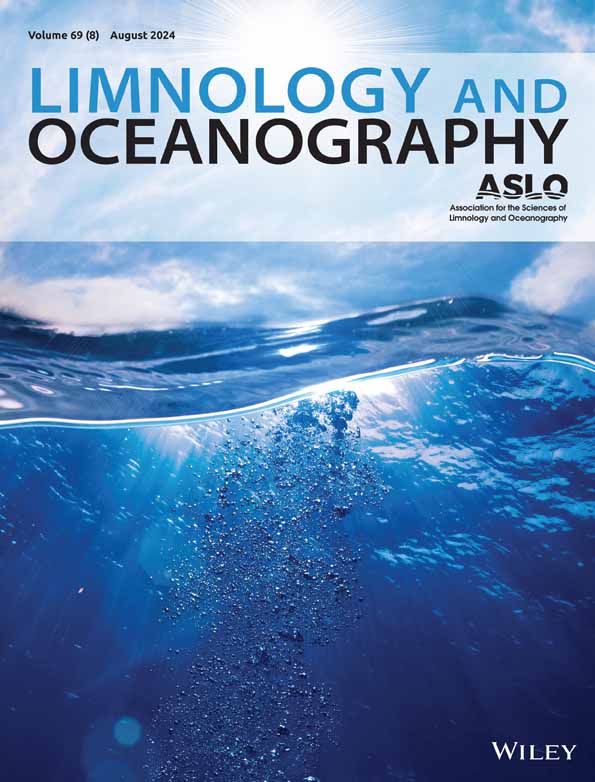高分辨率珊瑚氧和碳同位素记录揭示了地中海气候变化热点的温度和自养动力学
IF 3.7
1区 地球科学
Q1 LIMNOLOGY
引用次数: 0
摘要
地中海正在以超过全球平均水平的速度变暖。长期的、高分辨率的数据对于在更广泛的时间尺度内分析环境变化至关重要,而珊瑚骨架提供了有价值的环境档案,特别是在数据稀疏的地区或作为现有记录的补充。虽然基于珊瑚的重建在热带环境中已经建立,但在温带地区仍然有限。作为地中海唯一的建礁虫黄藻珊瑚,caespitosa对于在这些研究不足的地区扩大珊瑚环境档案尤为重要。本文报道了地中海西北部全球变化哨点C. caespitosa骨骼的δ18O和δ13C记录。本研究提供了最准确的C. caespitosa温度-δ18O校准方程,包括传统的线性模型和新的指数模型,该模型更好地解释了该地区较宽的季节温度范围。这两种校准都依赖于长期的原位水温数据和多珊瑚复合方法来减少非气候变率。δ13C的季节变化趋势首次揭示了珊瑚的自养-异养平衡的变化,而骨骼的地球化学异常表明热应力对生物矿化的影响。本研究结果为重建地中海地区人为变暖及其生态效应提供了重要的文献资料。本文章由计算机程序翻译,如有差异,请以英文原文为准。
High‐resolution coral oxygen and carbon isotope records reveal temperature and autotrophy dynamics in a Mediterranean climate change hotspot
The Mediterranean Sea is warming at a rate exceeding the global average. Long‐term, high‐resolution data are essential for contextualizing changes within broader temporal scales, and coral skeletons provide valuable environmental archives, especially in data‐sparse regions or as supplements to existing records. While coral‐based reconstructions are well established in tropical settings, they remain limited in temperate areas. As the only reef‐building zooxanthellate coral in the Mediterranean, Cladocora caespitosa is particularly important for expanding coral‐based environmental archives in these understudied regions. Here, we present records of δ18 O and δ13 C in the skeletons of C. caespitosa from a global change sentinel site in NW Mediterranean. This study provides the most accurate temperature–δ18 O calibration equations for C. caespitosa , including a traditional linear model and a novel exponential model that better accounts for the region's wide seasonal temperature range. Both calibrations rely on long‐term in situ water temperature data and a multi‐corallite composite approach to reduce non‐climatic variability. Seasonal trends in δ13 C reveal, for the first time, variation in the coral's autotrophy–heterotrophy balance, while geochemical anomalies in the skeletons signal thermal stress effects on biomineralization. Our findings establish C. caespitosa skeletons as critical archives for reconstructing anthropogenic warming and its ecological effects in the Mediterranean.
求助全文
通过发布文献求助,成功后即可免费获取论文全文。
去求助
来源期刊

Limnology and Oceanography
地学-海洋学
CiteScore
8.80
自引率
6.70%
发文量
254
审稿时长
3 months
期刊介绍:
Limnology and Oceanography (L&O; print ISSN 0024-3590, online ISSN 1939-5590) publishes original articles, including scholarly reviews, about all aspects of limnology and oceanography. The journal''s unifying theme is the understanding of aquatic systems. Submissions are judged on the originality of their data, interpretations, and ideas, and on the degree to which they can be generalized beyond the particular aquatic system examined. Laboratory and modeling studies must demonstrate relevance to field environments; typically this means that they are bolstered by substantial "real-world" data. Few purely theoretical or purely empirical papers are accepted for review.
 求助内容:
求助内容: 应助结果提醒方式:
应助结果提醒方式:


